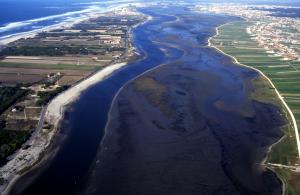Over the past 3 years the AQUACROSS Assessment Framework was developed, tested, and applied in eight case studies across Europe to solve local biodiversity challenges. Finally, results from each Case Study were published in a 30-page Case Study report and 3-page Executive Summary report.
The case study page summarises our work in Case Study 5, and makes recommendations for local policy.
| Find out more about Case Study Five: |
| Case Study Report |
| Executive Summary |
| Case Study Report Annexes |
| Case Study data and information on the AQUACROSS Information Portal |
Results from Case Study 5 are summarised below:
Biodiversity challenge: In 2018/2019, two management interventions will be implemented in the case study area that will have negative unintended impacts on biodiversity: 1) a dredging programme to enable hydrodynamic equilibrium and navigability in Ria de Aveiro coastal lagoon, and 2) the extension of a floodbank to disable surface saltwater intrusion into Baixo Vouga Lagunar agricultural area. The goal of this study is to apply adaptive management and address these foreseen but unintended management challenges in a Natura 2000 freshwater-marine continuum territory, in the context of EU water-related directives and EU Nature Directives.
Context: The geographic location of the case study combined with its natural capital enables a variety of economic, cultural and recreational activities. The region is subject to a complex variety of land and water uses and potential conflicts, and a number of anthropogenic pressures that impact the hydro-morphological conditions of the lagoon and the adjacent freshwater section of the Vouga River, the Baixo Vouga Lagunar. The region is also vulnerable to ocean storm surges and coastal erosion, and to torrential rain and flood events, meaning that it often requires human intervention for protection or to enable economic activities.
What was done?: We identify the overarching policy plans, programmes, and objectives relevant to managing biodiversity within the case study, as well as the key governance institutions. Stakeholders were engaged at different steps, contributing data, information, and perceptions to define the baseline and the management scenarios that were attained through: i) model-based scenarios built on causal links and habitat risk assessments; ii) stakeholders’ perceptions regarding the present status and future trends; and iii) modelling the spatial multicriteria analysis results that were attained by stakeholder’s valuation of ecosystem services.
Results: Two spatial scales, the entire Natura 2000 site and the Baixo Vouga Lagunar, were considered. The ecosystem-based management plan was co-created with input from local stakeholders and policy-makers. The plan proposes to restore saltmarshes and seagrasses, harmonise monitoring across EU Directives, and incorporate stakeholders and integrate territorial management instruments to mitigate the expected, unintended impacts of the floodbank and dredging in the Ria de Aveiro Natura 2000 site.
Lessons learned for managing biodiversity: The implementation of the proposed mitigation measures should be framed in the Sectoral Plan for Natura 2000 Network, which is the territorial management tool for the implementation of the national policy for the conservation of biological diversity; and should consider climate change projections and the National Strategic Plan for Climate Change adaptation. For the successful implementation of the identified water and nature policies at Ria de Aveiro Natura 2000 site, any actions need to ensure the involvement of users and landowners.
Applicability of results: The EBM plan is foreseen to support the development of the Vouga estuary management plan, as well as actions for a more comprehensive understanding of the social-economic implications of ecosystem services provided by these aquatic habitats.


